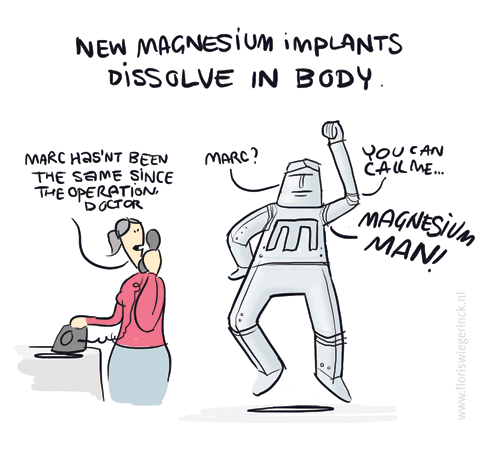When you break a limb, sometimes metal plates or pins must be implanted to help heal the bone. This technique however has its disadvantages. The solution: new types of materials that are as strong as human bone, but which simply degrade and disappear when they’re no longer needed.
“Operations are dangerous. Every operation carries the risk of infection. And sometimes people who undergo minor surgery nearly die because they develop life-threatening bacterial infections. Just imagine the gain then if we could reduce the number of operations necessary by half,” says dr. Jurek Duszczyk, head of the 3mE faculty’s biomaterials technology group. For the past few years year his group has been focusing on new types of biomaterials that could do just that: cut the number of operations by fifty percent. That is, the number of operations that require implants, for instance metal plates or screws to repair broken bones. This line of research has recently been strengthened through a collaboration between TU Delft and China’s Shanghai Institute of Ceramics, which became official last month.
The collaboration focuses on developing degradable bio-active composite materials. Dr. Zhiguang Huan, who came to Delft from China last February to exchange knowledge about these materials and conduct research in the TU’s specialized laboratory, explains what is unique about these composites: “There are a number of materials that can degrade by themselves when implanted in the human body. You don’t need an operation to remove them after they’ve done their work; they just disappear. Certain types of biopolymers can be used for this as well, but polymers are not very strong and don’t occur naturally in the human body. What we are interested in are alloys of magnesium. Magnesium is a type of metal that is present in our bodies naturally; it is a vital trace element and isn’t harmful for your health.” Duszczyk adds: “With magnesium we can make alloys that have a mechanical strength similar to that of human bone. When you use pins made of other types of metal to reconstruct bone, this material is often too strong. Consequently, the bone doesn’t have to carry a load anymore and will start to resorb. With magnesium alloys you can avoid this problem.”
If magnesium is such a wonderful material for implants, why then has it not already long been in use? Huan: “Surgeons already tried to use magnesium about sixty years ago, just after the Second World War. But they used pure magnesium. Pure magnesium is too weak and degrades too quickly. So these experiments didn’t work out well.” It’s only in the past few years that medical researchers have once again turned their attention to magnesium. Duszczyk: “At the moment there are some magnesium-based stents on the market, for cardiovascular surgery. And recently magnesium screws have started being used in orthopedic surgery. But the use of magnesium to make metal plates and pins for bone reconstruction, like we’re currently doing, is entirely new.”
There is still much to be gained from developing new magnesium alloys that have differing mechanical properties and degradation rates. The main focus of Huan’s research therefore is developing these new alloys and testing their physical and biomechanical properties. Promising materials are then sent to China, where in the lab of the Shanghai Institute they are tested in vitro and in vivo. The work Huan has done since coming to TU Delft has already resulted in three scientific papers, and the researchers estimate that at the current pace of research, magnesium plates and pins could be commercially available within a few years.
A tour of the laboratory reveals that there is more to making objects out of magnesium alloys then one might think. For starters, the group uses powders. It then takes a number of complicated steps including mixing, binding, molding, sintering and finally the sizing and shaping to make objects like a pin or plate from these powders. The reason why the objects are not simply cast is that by using the more complicated procedures you can control the porosity of the objects and put bio-active compounds in them. This is an important focus of other researchers within Duszczyk’s group: “We are for instance looking into the option of putting drugs inside the porous surface of the implants, or mixing them with the alloy. Imagine the possibilities! We could include drugs like painkillers, or drugs that enhance bone growth. And these drugs would slowly be released at the exact location where you want them to be active, while the implant degrades.”
Freelance jobs available writing for Delta’s English Pages. We seek students/staff to write articles in English, for payment, on a freelance basis. No experience necessary. We’re looking for enthusiastic, creative foreign students/staff to contribute articles, cartoons, illustrations and photographs. Interested, please send a brief introductory email to: d.mcmullin@tudelft.nl



Comments are closed.